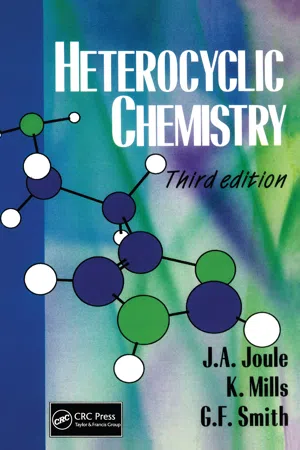
eBook - ePub
Heterocyclic Chemistry, 3rd Edition
John A. Joule
This is a test
- English
- ePUB (adapté aux mobiles)
- Disponible sur iOS et Android
eBook - ePub
Heterocyclic Chemistry, 3rd Edition
John A. Joule
Détails du livre
Aperçu du livre
Table des matières
Citations
À propos de ce livre
Covering the fundamentals of heterocyclic reactivity and synthesis, this book teaches the subject in a way that is understandable to graduate students. Recognizing the level at which heterocyclic chemistry is often taught, the authors have included advanced material that make it appropriate for postgraduate courses. The text discusses the chemical reactivity and synthesis of particular heterocyclic systems. Exercises and solutions help students understand and apply the principles. Original references are included throughout, as well as many review references.
Foire aux questions
Comment puis-je résilier mon abonnement ?
Il vous suffit de vous rendre dans la section compte dans paramètres et de cliquer sur « Résilier l’abonnement ». C’est aussi simple que cela ! Une fois que vous aurez résilié votre abonnement, il restera actif pour le reste de la période pour laquelle vous avez payé. Découvrez-en plus ici.
Puis-je / comment puis-je télécharger des livres ?
Pour le moment, tous nos livres en format ePub adaptés aux mobiles peuvent être téléchargés via l’application. La plupart de nos PDF sont également disponibles en téléchargement et les autres seront téléchargeables très prochainement. Découvrez-en plus ici.
Quelle est la différence entre les formules tarifaires ?
Les deux abonnements vous donnent un accès complet à la bibliothèque et à toutes les fonctionnalités de Perlego. Les seules différences sont les tarifs ainsi que la période d’abonnement : avec l’abonnement annuel, vous économiserez environ 30 % par rapport à 12 mois d’abonnement mensuel.
Qu’est-ce que Perlego ?
Nous sommes un service d’abonnement à des ouvrages universitaires en ligne, où vous pouvez accéder à toute une bibliothèque pour un prix inférieur à celui d’un seul livre par mois. Avec plus d’un million de livres sur plus de 1 000 sujets, nous avons ce qu’il vous faut ! Découvrez-en plus ici.
Prenez-vous en charge la synthèse vocale ?
Recherchez le symbole Écouter sur votre prochain livre pour voir si vous pouvez l’écouter. L’outil Écouter lit le texte à haute voix pour vous, en surlignant le passage qui est en cours de lecture. Vous pouvez le mettre sur pause, l’accélérer ou le ralentir. Découvrez-en plus ici.
Est-ce que Heterocyclic Chemistry, 3rd Edition est un PDF/ePUB en ligne ?
Oui, vous pouvez accéder à Heterocyclic Chemistry, 3rd Edition par John A. Joule en format PDF et/ou ePUB ainsi qu’à d’autres livres populaires dans Sciences physiques et Chimie. Nous disposons de plus d’un million d’ouvrages à découvrir dans notre catalogue.
Informations
Structures and main physical properties of aromatic heterocycles | 1 |
This chapter describes the structures of aromatic heterocycles and gives a brief summary of some physical properties.1 The treatment we use is the valence-bond description, which we believe is sufficient for the understanding of all heterocyclic reactivity, perhaps save some very subtle effects, and is certainly sufficient for a general text-book on the subject. The more fundamental molecular-orbital description of aromatic systems is still not so relevant to the day-to-day interpretation of heterocyclic reactivity, though it is necessary in some cases to utilise frontier orbital considerations,2 however such situations do not fall within the scope of this book.
1.1 CARBOCYCLIC AROMATIC SYSTEMS
1.1.1 Structures of benzene and naphthalene
The concept of aromaticity as represented by benzene is a familiar and relatively simple one. The difference between benzene on the one hand and alkenes on the other is well known: the latter react by addition with electrophiles, such as bromine, whereas benzene reacts only under much more forcing conditions and then nearly always by substitution. The difference is due to the cyclic arrangement of six π-electrons in benzene: this forms a conjugated molecular orbital system which is thermodynamically much more stable than a corresponding non-cyclically conjugated system. The additional stabilisation results in a diminished tendency to react by addition and a greater tendency to react by substitution for, in the latter manner, survival of the original cyclic conjugated system of electrons is ensured in the product. A general rule proposed by Hückel in 1931 states that aromaticity is observed in cyclically conjugated systems of 4n + 2 electrons, that is with 2, 6, 10, 14, etc., π-electrons; by far the majority of monocyclic aromatic, and heteroaromatic, systems are those with 6 π-electrons.
In this book we use ...
Table des matières
Normes de citation pour Heterocyclic Chemistry, 3rd Edition
APA 6 Citation
Joule, J. (2020). Heterocyclic Chemistry, 3rd Edition (3rd ed.). CRC Press. Retrieved from https://www.perlego.com/book/2011760/heterocyclic-chemistry-3rd-edition-pdf (Original work published 2020)
Chicago Citation
Joule, John. (2020) 2020. Heterocyclic Chemistry, 3rd Edition. 3rd ed. CRC Press. https://www.perlego.com/book/2011760/heterocyclic-chemistry-3rd-edition-pdf.
Harvard Citation
Joule, J. (2020) Heterocyclic Chemistry, 3rd Edition. 3rd edn. CRC Press. Available at: https://www.perlego.com/book/2011760/heterocyclic-chemistry-3rd-edition-pdf (Accessed: 15 October 2022).
MLA 7 Citation
Joule, John. Heterocyclic Chemistry, 3rd Edition. 3rd ed. CRC Press, 2020. Web. 15 Oct. 2022.